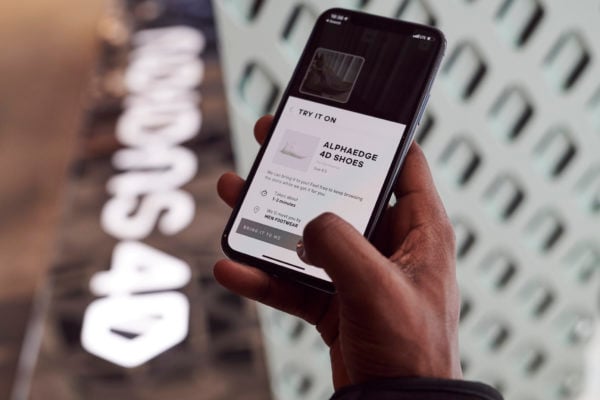Can technology revive retail post-COVID? Here are 5 ways retailers can embrace mobile to transform the shopping experience…

Can technology revive retail post-COVID? Here are 5 ways retailers can embrace mobile to transform the shopping experience…

Can technology revive retail post-COVID? Here are 5 ways retailers can embrace mobile to transform the shopping experience…
Post-COVID, retailers will need to work even harder to adapt to changes in consumer behaviour. That means focusing on customer experience and doubling down on digital.
From simplifying the checkout process to helping customers locate items – there are plenty of ways mobile devices can help deliver a complete experience to shoppers in the retail environment.
But while 71% of shoppers now use their mobile devices while shopping in-stores, great mobile retail experiences are still few and far between. With this in mind, here are 5 ways retailers can begin to integrate mobile experiences today, to improve the customer experience and remain competitive.
Heading into 2020, around 50% percent of retailers planned to prioritise a mobile app or point-of-sale experience. Now, in response to COVID, many more companies have accelerated their app efforts too – including Sainsbury’s.
The UK’s third biggest supermarket chain is heavily investing and innovating in digital, in reaction to both the pandemic and ever-changing consumer habits. Sainsbury’s is currently trialling an app which provides a virtual queuing system, aiming to help customers stay safe, save time and shop conveniently in its stores.
Currently live in five stores across the UK, the trial app is the first technology of its kind to be tested in the UK. If successful, similar apps could soon become the new normal for supermarkets and other large retailers.

These days, we can make a purchase at the tap of a screen with our goods arriving the next day. So how do we keep driving customers in-store? Linking its mobile app to its in-store experience, Sephora uses personalised in-app messaging to encourage customers to book makeovers and consultations in-store.
The Sephora app delivers genuine value as it drives consumers in-store while making shopping trips easier, more engaging and more fun.
The B&Q loyalty app is another great example of giving customers a reason to go in-store. Rather than rewarding purchases with loyalty points, the B&Q Club app instead offers exclusive discounts on various products, driving consumers in store to purchase.

Adidas’ flagship store in London has reinvented the in-store shopping experience. The ‘Bring it to me’ app combines real-time personalisation with convenience, enabling shoppers to scan products, request their size and make a purchase.
Simply point your phone at a pair of trainers you like and the app will ask you to select your size. In no time at all, a staff member will bring you your chosen trainers – using your location to find your whereabouts in-store. In addition to the app, shoppers can interact with smart mirrors that display product information in the store’s changing rooms.
Retailers must continue to think about how they can integrate mobile experiences that work in tandem with the in-store experience.
The John Lewis app was developed to enhance the in-store journey and bring the customer experience together by providing an omnichannel experience that makes it simple to shop.
The perfect in-store shopping companion, the high-end department store’s app helps customers find product information, access their loyalty cards and navigate the store – providing a seamless, high-quality experience across channels that allows shoppers to navigate seamlessly between online and brick-and-mortar stores.
Fluid shopping experiences across digital and physical worlds, like the one John Lewis provide, will ensure shoppers keep coming back for more.
Is your store Insta-worthy? As AdWeek puts it, “These days, if consumers can’t Instagram a store, it’s almost not even worth going.”
Current consumers crave experiences they can share on social media. From setting up Instagrammable walls and product displays to encouraging selfie sharing with in-store incentives – there are plenty of ways retailers can inspire Instagrammers to head in-store.
Women’s clothing shop, The Reformation, provides smart changing rooms with customisable lighting and music, and mirrors made for selfies – giving consumers an experience they can’t get online and a shareable shopping experience.
Mobile experiences are a great way to amplify your omnichannel marketing. It can be as simple as combining an Instagram-friendly display with an incentive to use it, and as complex and holistic as adidas's futuristic mobile-enabled experience.
The common ground in all these approaches is understanding that mobile is central to how consumers shop. The ideas outlined here focus around offering consumers at least one of the following:
Utility – something that makes life easier
Incentive – ideas that are fun to use and drive the user to engage in store
Immersion – the unique connection consumers have to their smartphones means it's a direct line to their attention
Omnichannel – mobile is both a channel and the common denominator across all channels, including retail
Shareability – mobile is the de facto vehicle for social sharing, and thus an ideal channel to drive engagement on social platforms.
If you'd like some ideas for your brand, get in touch.
Read more about how to improve your customer-centricity in our resource: Why consumer centric retail marketing gets results (and how to do it).
Follow us on:
Terms of use Privacy policy Cookie statement Modern slavery statement Tax strategy
Copyright ©2025 Indicia Worldwide
